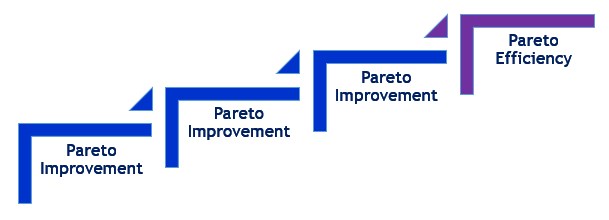Pareto Efficiency
Pareto efficiency, also known as Pareto optimality, is a situation where resources cannot be reallocated to make one individual or condition better off without making at least one other individual or condition worse off.
In Pareto Efficiency, resources are allocated in the most efficient way possible.
Pareto Efficiency and Pareto Improvement
Pareto Efficiency is a balance of resource distribution where one individual or condition cannot be improved without worsening the condition of another individual or condition. If there are options to make a situation better without adversely affecting anything else, it would not be Pareto Efficient yet.
Pareto Inefficient
Pareto Inefficient is a situation when it is possible to make someone or a condition better off without making someone else or another worse off. In other words, if there is room to improve one area without adversely affecting another areas, it is Pareto inefficient.
For example, if an auditorium is at full capacity, with no available seats, the use of the room would be Pareto efficient. In this case, the only way to allow another person into the auditorium to watch a play is to remove an existing person and allocate their seat to the new person. Conversely, the auditorium would be considered Pareto inefficient if there are still seats available.

Pareto Improvement
In order to attain Pareto Efficiency, all Pareto Improvements need to be completed. A Pareto Improvement is a change in allocation that makes at least one individual or condition better off without making any other individual or condition worse off. Basically, it is a change that benefits at least one side without causing harm to another.
For example, in a manufacturing plant, Pareto improvement trials can be run to see if there are any areas in which production efficiency can be improved. The company would attempt to reallocate resources such as workers, machinery, or supplies to different areas of the production lines and evaluate possible changes in production outputs. If there were any positive changes, without any adverse effects, the company would keep the change. However, if the company had adverse effects, it would not keep the change.
If the company moves one employee from one production line to another, there may be an increase in productivity in one line, but that will likely be offset by the decrease in the other. Therefore, this is not a Pareto improvement since a negative outcome occurred.
According to the theory, it is best to continue to make Pareto improvements until it is no longer possible to do so because a benefit to one side would worsen the situation of one or more others. When no further Pareto improvements can be made, “Pareto efficiency” is said to have been reached. Hence, Pareto efficiency is reached when all areas within a system have completed all of the Pareto improvements available.
An allocation is not Pareto efficient if there is an alternative allocation where improvements can be made to at least one side without reducing any other side well-being. In other words, Pareto Efficiency indicates that resources can no longer be allocated in a way that makes one side better off without harming another.
Using Pareto Efficiency
Pareto efficiency is used to determine when an allocation is optimal. It is helpful when determining how to get the most value in a situation that requires trade-offs. However, even when efficiency has been reached, that does not mean that all participants or conditions in the organization are achieving the same levels of production, only that no other improvements can be made without a detriment to another.
Additionally, even though Pareto efficiency implies that resources are allocated in the most efficient manner, it does not imply equity or fairness.

